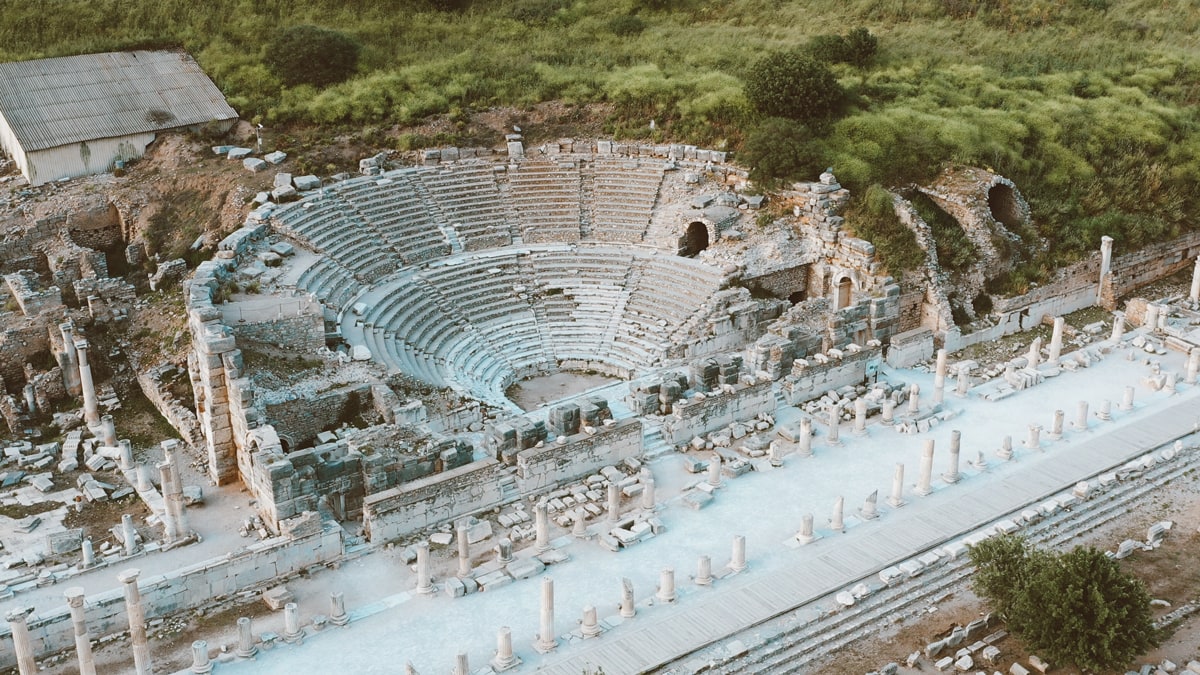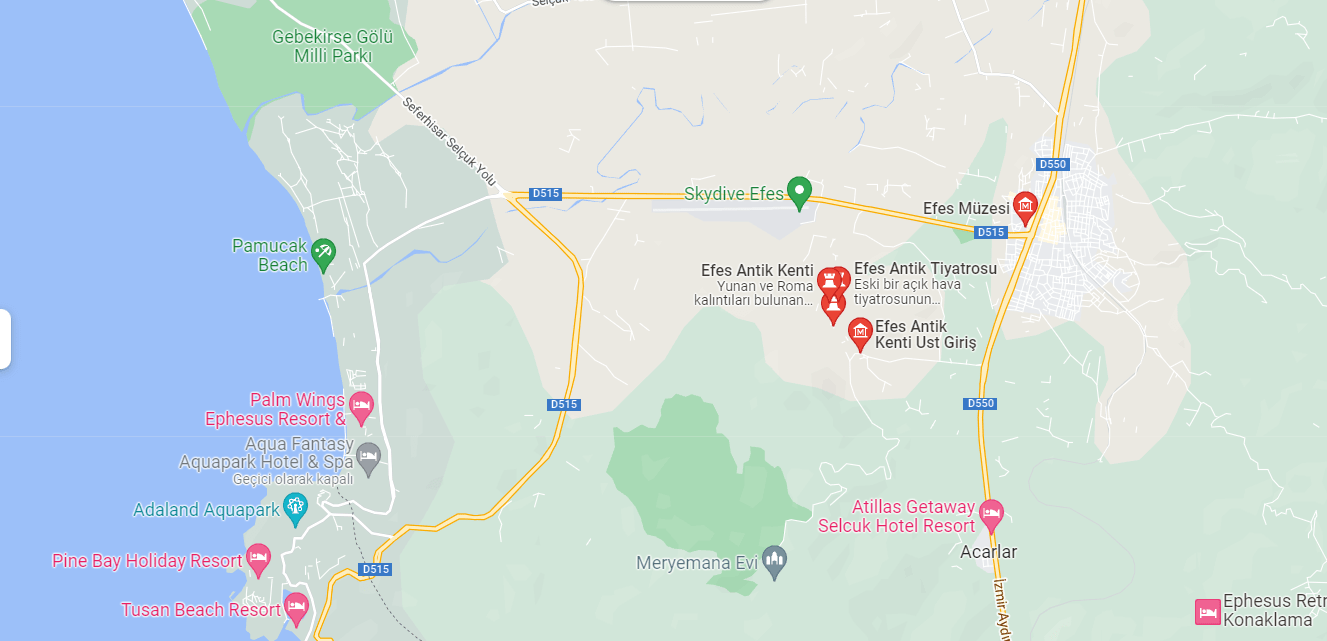The “Ephesus” World Heritage Site, which was included in the World Heritage List, consists of four components: Çukuriçi Mound, Ayasuluk Hill (Selçuk Castle, St. John’s Basilica, Isa Bey Bath, Isa Bey Mosque, Artemision), Ancient City of Ephesus and House of Virgin Mary.
The ancient city of Ephesus began as a simple settlement in 8600 BC. It grew over the centuries and became one of the most crucial world capitals of its time.
The city developed thanks to the fact that the Selçuk district of Izmir, where it was founded, was one of the most fertile lands of Anatolia; trade routes passed through here, and it had a harbor connecting the east and west of the world. Its golden age came after it was annexed to the Roman Empire in 129 BC. It became the capital of the province of Asia. During this period (2nd-1st century BC), Ephesus became one of the largest metropolises of its time, with a population of over 200,000 people.
The wealth accumulated in the city is reflected in the architecture. It is possible to guess how impressive the city is from the splendor of the Library of Celsus, which has been brought back to its feet and exhibited. It is said to compete with Rome.
The city’s most famous structure is the Temple of Artemis, one of the 7 wonders of the world, built by the Lydian king Creseus in 550 BC before the city fell to the Romans. Unfortunately, all that remains of the temple today are a few pieces of stone and a column that was later reassembled. Artemis, a Greek goddess, is thought to be the continuation of Cybele, the Anatolian goddess of fertility, and synthesized into Greek culture.
Ephesus was home to people of many religions and races. St. John, who trusted the atmosphere of tolerance here, brought his mother, Mary, entrusted to him by Jesus in 36 AD, here for her safety after Jesus’ crucifixion in Jerusalem. Today, the house where the Virgin Mary lives is a pilgrimage point visited by Christians worldwide.
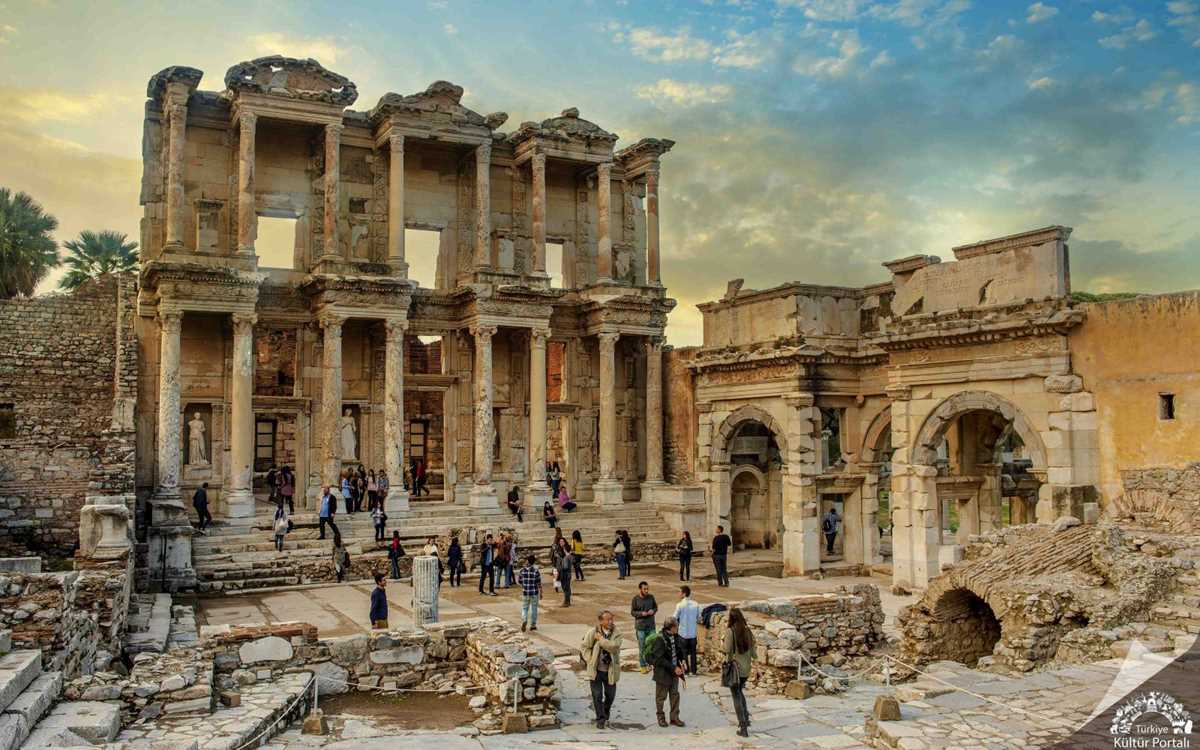
St. Paul worked hard to spread Christianity in Ephesus, preaching one of his famous sermons there. By converting many people to Christianity, Ephesus played an essential role in spreading the religion. In 313, Christianity became the official religion of Rome. By 380, paganism was seemingly over as the Catholic faith was imposed on the city’s inhabitants.
Ephesus had been sacked many times, suffered earthquakes, and changed hands, but it had always continued. However, it could not resist after the preparation of Küçük Menderes. The river filled the harbor with alluvium, leading to the end of maritime trade and the city’s decline. The declaration of Istanbul as the new capital of the Eastern Roman Empire further weakened the already weak city. Its economy was now based on being a pilgrimage center. In the 6th and 7th centuries, devastating earthquakes also took their toll. People fleeing from the Arab invasions set up other settlements and emptied the city, and it was never able to return to its former glory.
The settlement, which could not turn its fate around during the Seljuk and Ottoman periods, is now experiencing its most flourishing times after the Roman year’s thanks to the tourist buses arriving at all hours of the day. Below you will find our suggestions and some helpful information for your trip to the ancient city of Ephesus.
History of Ephesus Ancient City
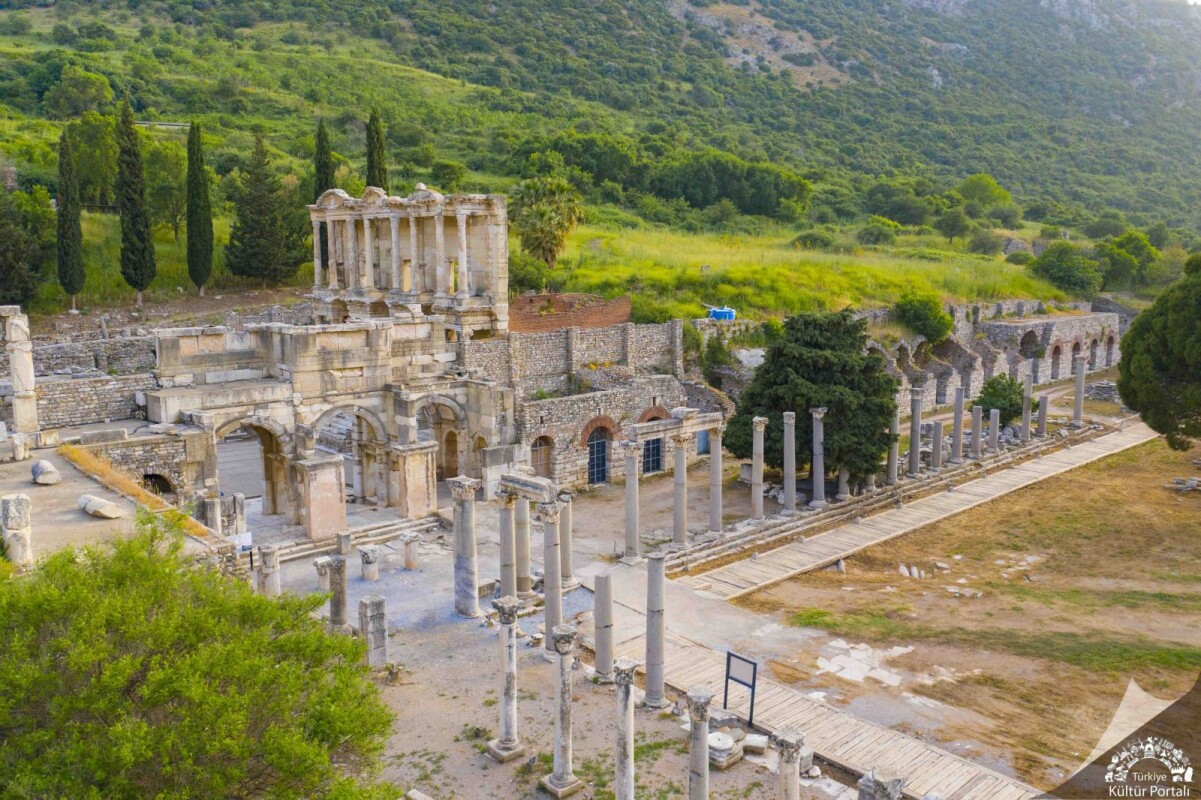
Ephesus that noble city whose foundation dated back to 6000 BC and was used as an active settlement from the Hellenistic period to the Roman, Byzantine (Eastern Roman), Principalities, and Ottoman periods.
Being an example of superior urban planning for centuries, being a trade center as a result of being a port city of great importance, being a cradle of cultures as an inevitable result of hosting civilizations with a vibrant culture for thousands of years, being accepted as the pilgrimage center of Christianity and being a religious center for centuries; I think it would not be wrong to say that Ephesus is not a part of history but history itself.
The Myth that Amazon Women Founded
It is rumored that Ephesus was first founded by female warriors known as amazons, and even its name comes from Apasas, a city of the Arzawa (City of the Mother Goddess) Kingdom. Although there is not much clear information about this period, it is thought that locals lived in this region for many years.
Ephesus as a World Capital: Hellenistic and Roman Periods
The region, which was previously thought to be a small center of life, gained importance and was strengthened by the hands of Androklos, Prince of Athens. At the entrance of the Temple of Hadrian in the ancient city of Ephesus, there are the following sentences describing the foundation of Ephesus;
“Androclos, the brave son of Kodros, the king of Athens, wanted to explore the opposite side of the Aegean. First, he consulted the oracles of the Temple of Apollo in Delphi. The oracles tell him that he will build a city where the fish and the pig point. While Androklos ponders the meaning of these words, he sets sail for the dark blue waters of the Aegean… They decide to land when they reach the gulf at the mouth of the Kaystros (Küçük Menderes) River. While they are cooking the fish they caught by lighting a fire, a wild boar emerges from the bushes, snatches the fish, and runs away. The prophecy was fulfilled. They decide to build a city here… “
The growth process of Ephesus, which started with Androclus, reached its peak in 129 BC when Attolos, King of Pergamon, bequeathed the region to the Romans. Leaving a whole country as an inheritance is fascinating, but fortunately, it worked for Ephesus. After this date, Ephesus became the most important trade center in Asia, according to historians. In addition, the school of philosophy opened here also played a significant role in making it an important center.
With the emergence of Christianity, the city became a religious center, first with the presence of St. Paul, one of the most important figures of the Bible, who preached here for a while, and later with the arrival of St. John and the Virgin Mary. Ephesus, which lived its golden age from this date onwards, started to change hands frequently and draw an unstable momentum. And finally, in 1304, it was captured by the Turks.
Principalities and Ottoman Period
In 1304, Ephesus passed to the Turkish principalities and prospered for 98 years, but in 1402 it was hit by Mongol attacks and suffered great destruction. In 1425, the city was conquered by the Ottomans. After this point, Ephesus rapidly lost its importance, and by the 20th century, the sands carried by the Menderes River had expanded the plain. Ephesus, a coastal city, is about 5 km from the sea.
Information for Visiting Ephesus Ancient City
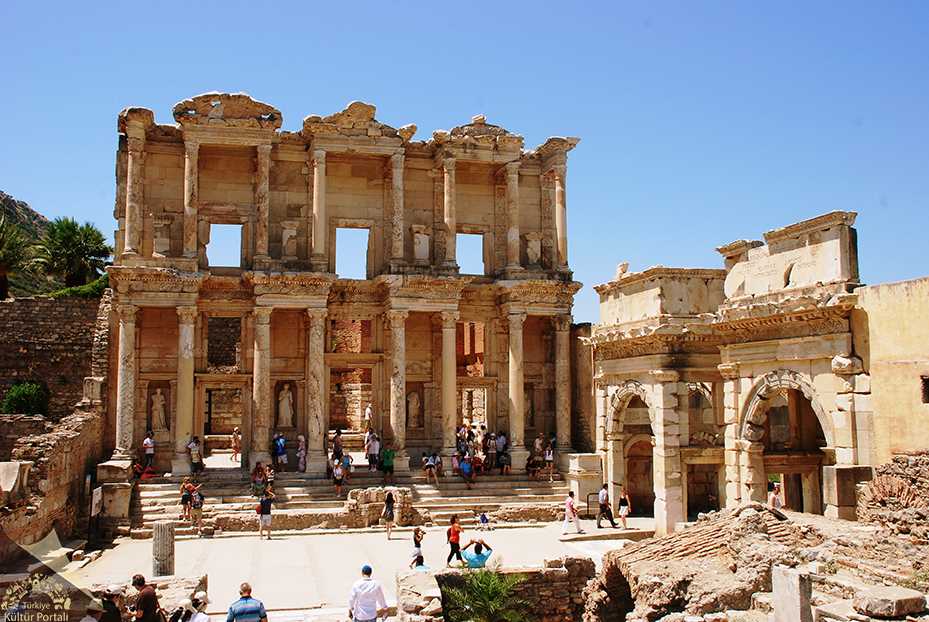
When to Visit?
The best time to visit Ephesus, which you can easily visit throughout the year, is in May because of the greening of nature.
Most visitors come in the summer, but visiting Ephesus in the heat of Izmir can be challenging. If you are coming in the summer, it is best to be here when the gates open. You will be comfortable in terms of temperature and can take photos comfortably without crowds. Ensure you have water, sunscreen, and a hat in your bag.
How long does it take to visit the ancient city of Ephesus?
You should spend at least 2-3 hours here. It may sound like a lot, but remember that you are visiting a metropolis. The guided walking tour also takes 2 hours. If you visit both the Ancient City of Ephesus and other essential points, such as the House of the Virgin Mary and the Temple of Artemis, the tour will take 4-5 hours.
Is there an entrance fee to the Ancient City of Ephesus?
Yes, there is. There is no discount.
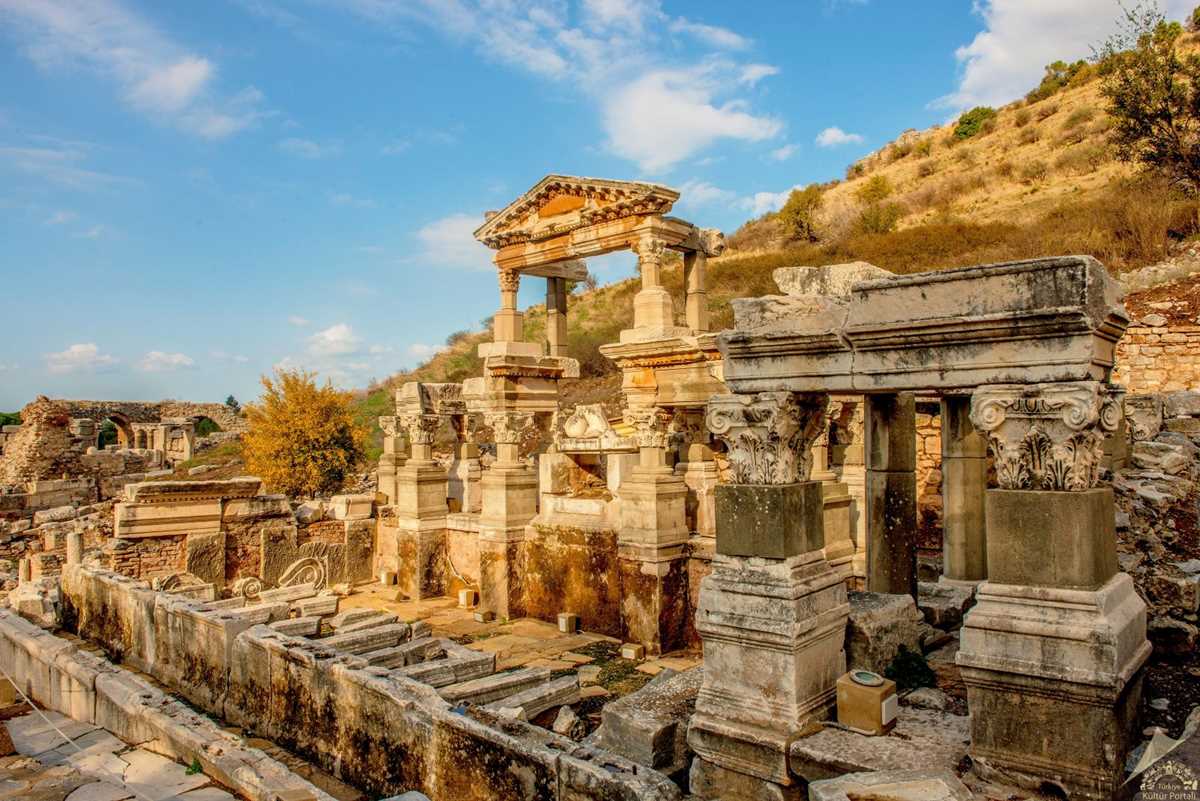
Does Museum Card Pass at Ephesus Ancient City?
Yes, it is. Museum Card holders can visit the Ancient City of Ephesus free of charge 2 times a year. If you don’t have a Museum Card, there is also a Museum Card sales point where you can get one immediately. It is much more convenient than buying any ticket. In addition, Müzekart is also valid for entrances to the Slope Houses, St. Jean Ruins, and Ephesus Museum.
Visiting Hours of Ephesus Ancient City
- Summer Period April 1 – October 1 Opening Time: 08:00 Closing Time: 19:00
- Winter Period: October 1 – April 1 Opening Time: 08:30 Closing Time: 18:00
- Open every day. Closed only until noon on the first day of religious holidays.
Is There a Parking Lot in the Ancient City of Ephesus?
Those who will come here in their own car can park for a fee at the main entrance.
Ephesus Ancient City Tours
Many travel agencies organize day or overnight tours to the ancient city of Ephesus. It’s up to you whether you prefer well-known or more local agencies. If you have time, our favorite is to enjoy it on your own instead of such superficial tours, but if you get a chance from Izmir, day tours are definitely better than not seeing it at all. The daily terms starting from Izmir are usually 50-100 TL, and the price depends entirely on the transportation and food they provide. Şirince and the House of the Virgin Mary are typically included in the tours.
If you prefer to take a tour from Istanbul or relatively distant cities like Istanbul, it is definitely with accommodation. Prices can vary depending on the number of nights you stay, the hotel, and the places you visit. Çeşme etc., can also be added to more comprehensive 3-4 day tours. Since the terms take shape as the summer season approaches, it is best to check the content and prices for the summer.
Places inside the Ancient City of Ephesus
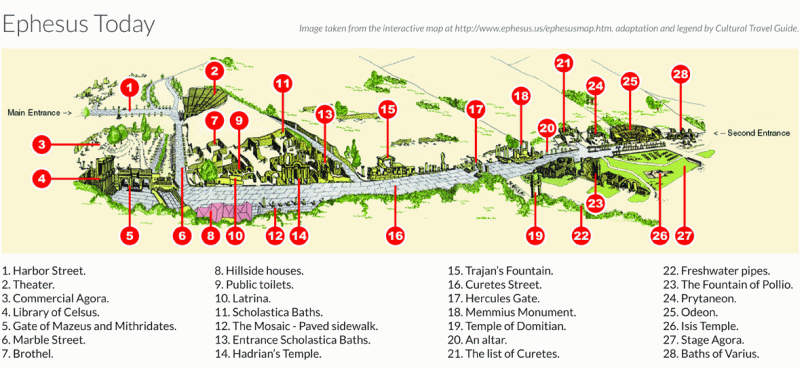
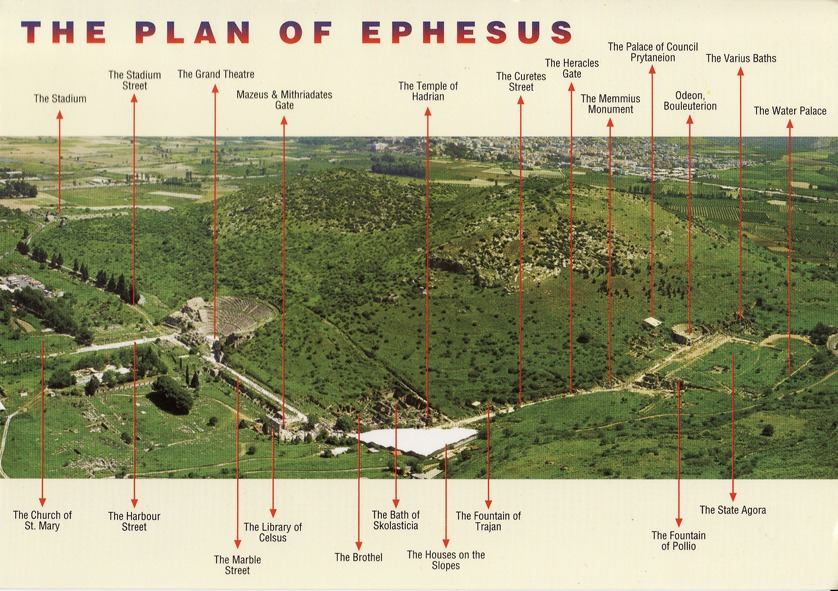
Ephesus is, of course, a priceless treasure with every inch of it, but some structures stand out in Ephesus, which would be a shame if we visited without a bit of knowledge.
Harbor Street
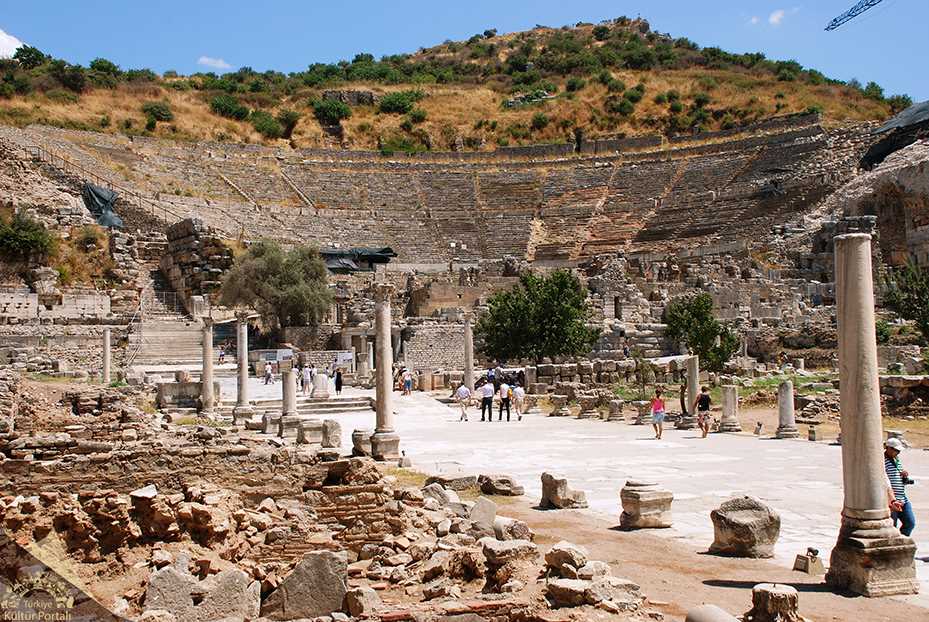
Arcadian Street, or Harbor Street, is the longest street in the Ancient City of Ephesus. It connects the Odeon and the Ancient Harbor. Both sides of the street are decorated with magnificent columns. In the past, kings coming to the city were welcomed on this street, and religious ceremonies were organized on this road.
Ancient Theater of Ephesus (Grand Theater)
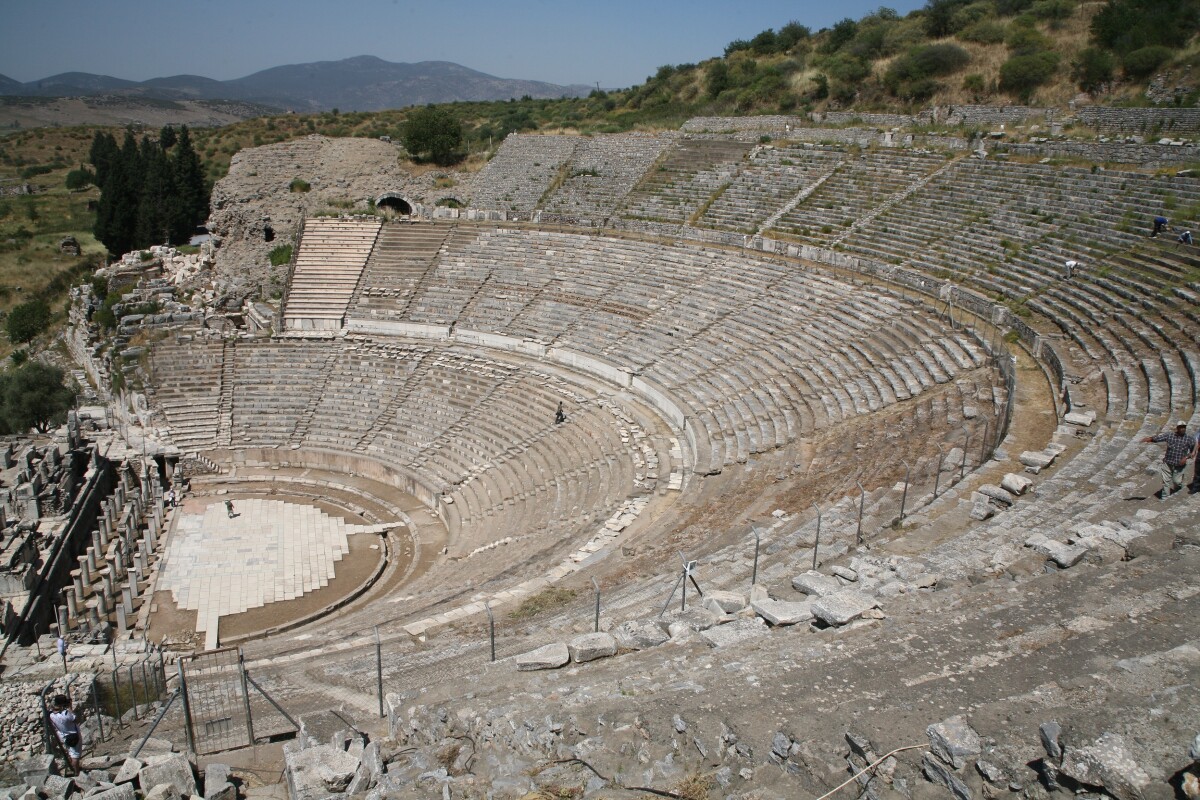
This theater, which is the largest open-air theater of the ancient period, has a capacity of 24,000 people. Unfortunately, the theater’s stage has been destroyed, but the seating areas are in good condition. Apart from being the most prominent theater, it is also where St. Paul’s sermons took place, so it is an essential work for Christianity.
Commercial Agora
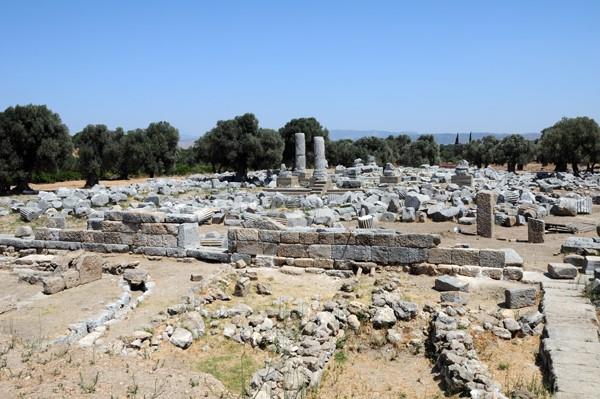
Located right next to the Library of Celsus, the square is the Agora, the city’s most important commercial and cultural center and marketplace. The Agora, which has a total of 3 gates, was founded in the 3rd century BC during the reign of Emperor Augustus. The Agora was damaged by a great earthquake in the 4th century AD and became unusable.
Temple of Serapis
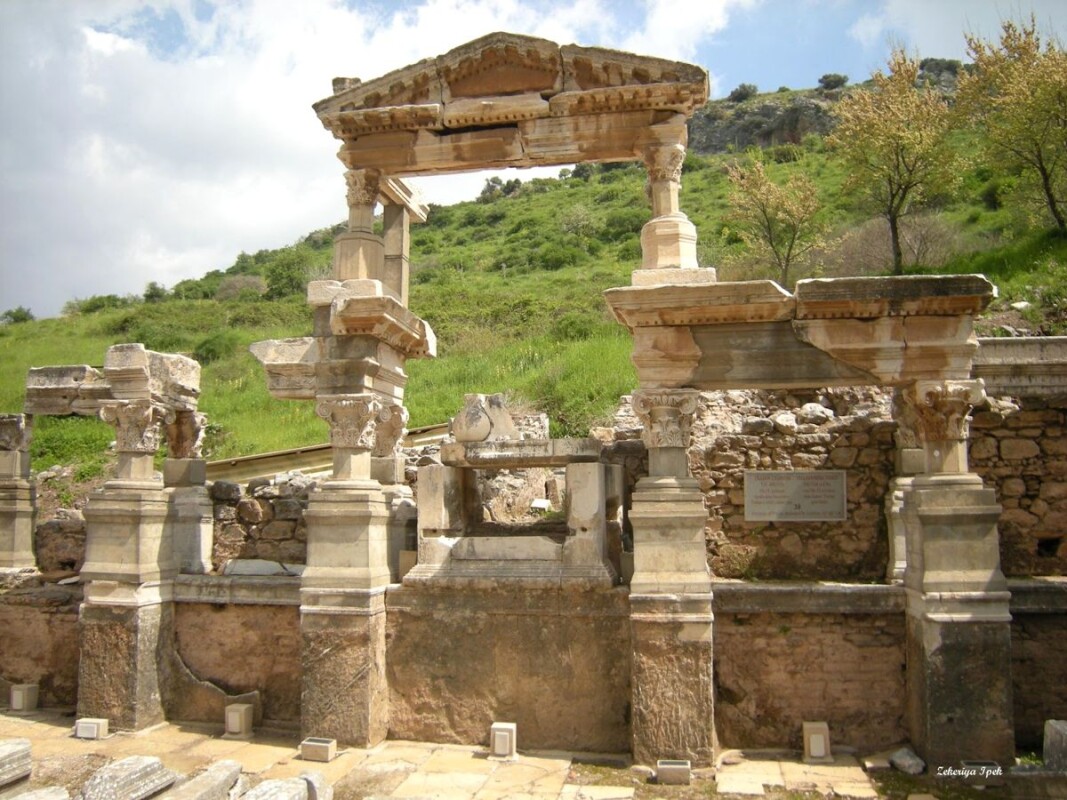
The Temple of Serapis, located behind the Library of Celsus, is one of the fascinating structures of Ephesus, thought to have been built between 138-192 AD. Serapis is an Egyptian god. It is believed that the temple made of Egyptian granite was dedicated to the followers of the Serapis religion. The temple was converted into a church during the Christian era, but the inscriptions found during excavations revealed that the temple was actually dedicated to Serapis.
Library of Celsus
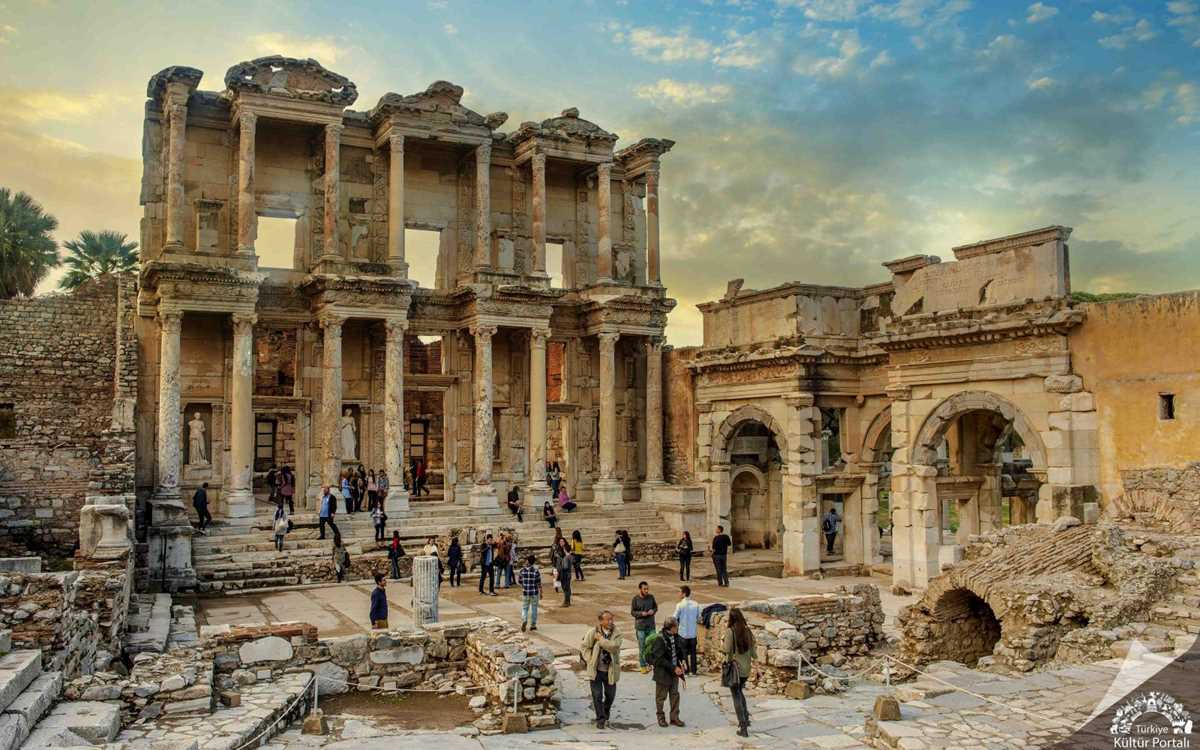
Perhaps the most beautiful building in Ephesus. The Celsus Library was built by his son on behalf of Celsius, the governor of Ephesus, who died in 106 AD. Although the library looks like a two-story building from the outside, it is a single-story and high-ceilinged construction from the inside.
There is an astonishing and funny claim about this place. There is a brothel just opposite the library. Looking at other ancient cities, this is not a first. However, the claim is that a secret passage leads from the library to this brothel. It is rumored that people at that time went to the brothel this way without attracting attention in society or getting caught by their wives. Well, what can we say if it’s a joke, it’s even funnier if it’s not.
Mazeus Gate and Mithridates
The Mazeus Gate, also known as the South Gate of the Agora, provides access from the Library of Celsus to the Trade Agora. Thought to have been built in 4th-3rd BC, the gate was financed and constructed by two enslaved people, Mazaeus and Mithridates, who were freed by Emperor Augustus.
Marble Street
The street stretches from the library square to the theater and is called Marble Street. The road is also designed for the passage of cars, and there are sidewalks for pedestrians on both sides. The street is decorated with columns along its length.
House of Love
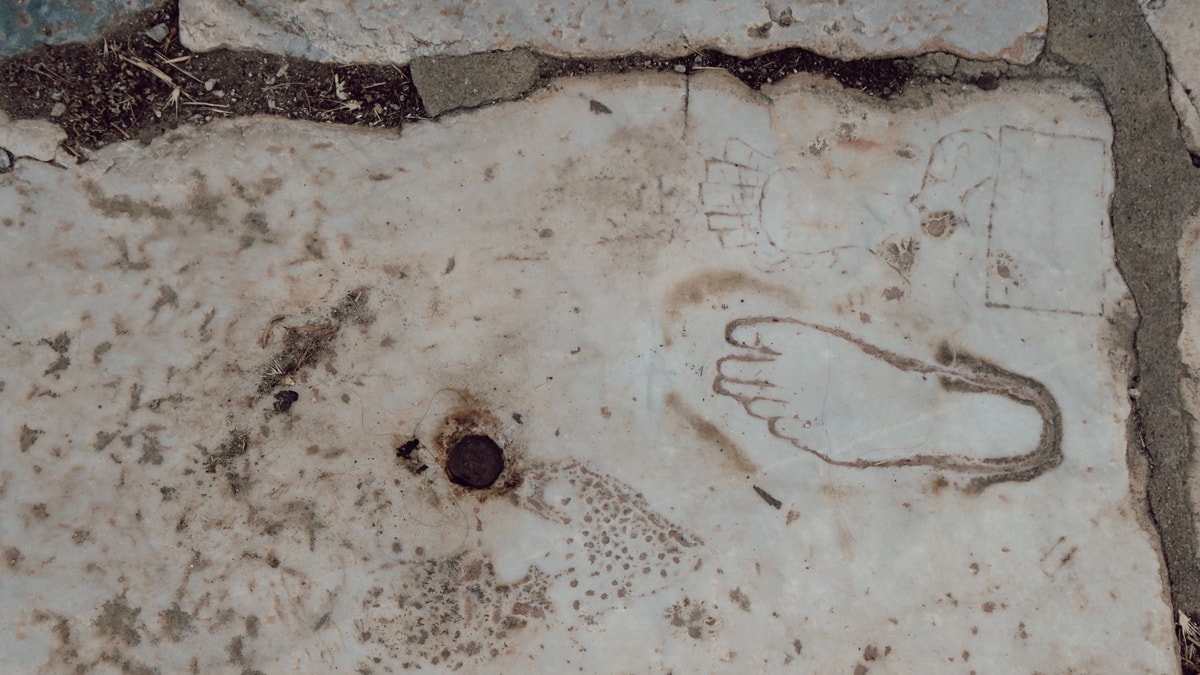
At the intersection of Kuretler Street and Marble Street is the love house. The love house was the brothel of the period. It is thought that there were underground connections to the love house through secret passages from many buildings in the city. These passages have yet to be unearthed, but it is assumed that they were frequently used by married men of Ephesus. The footprint you see in the photo probably belongs to a sex worker who worked in the House of Love. The fact that this footprint is located at the entrance of the House of Love makes it a kind of billboard of the time.
Hillside Houses
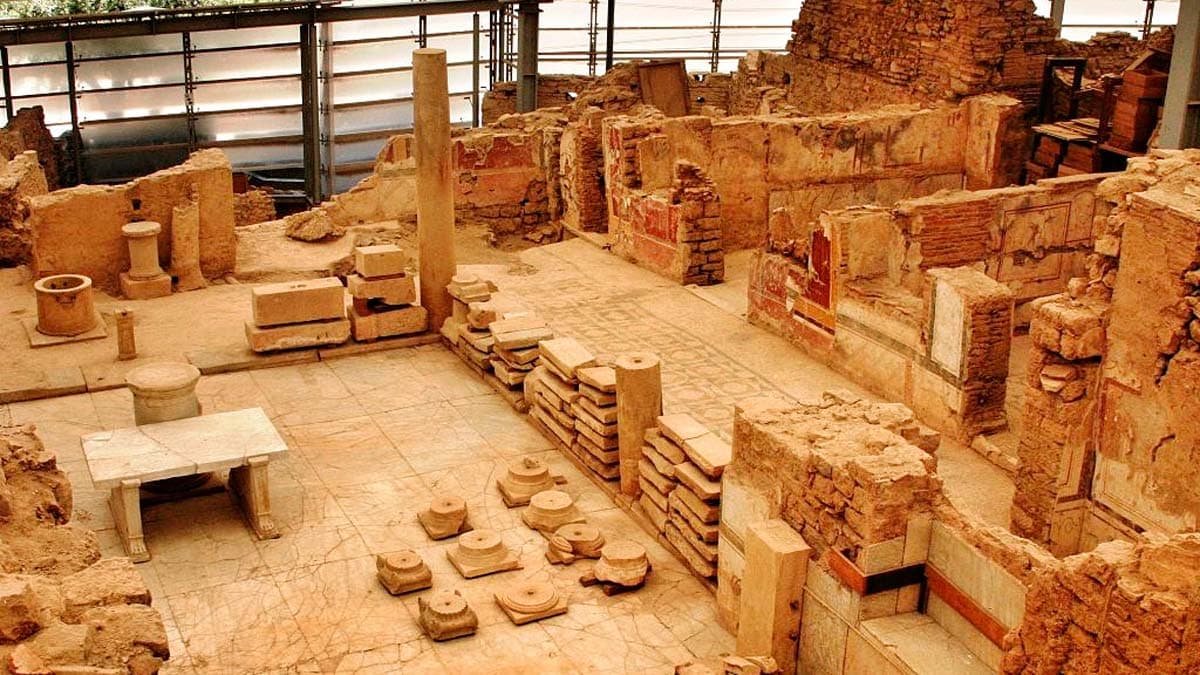
It’s time for the site of the rich of Efes. Each house has a courtyard built on a 4000 m² area. The homes were so luxurious for the period that they were heated with underfloor heating. These houses, used until the city was abandoned, are now in good condition for sightseeing.
Public Toilet (Latrina)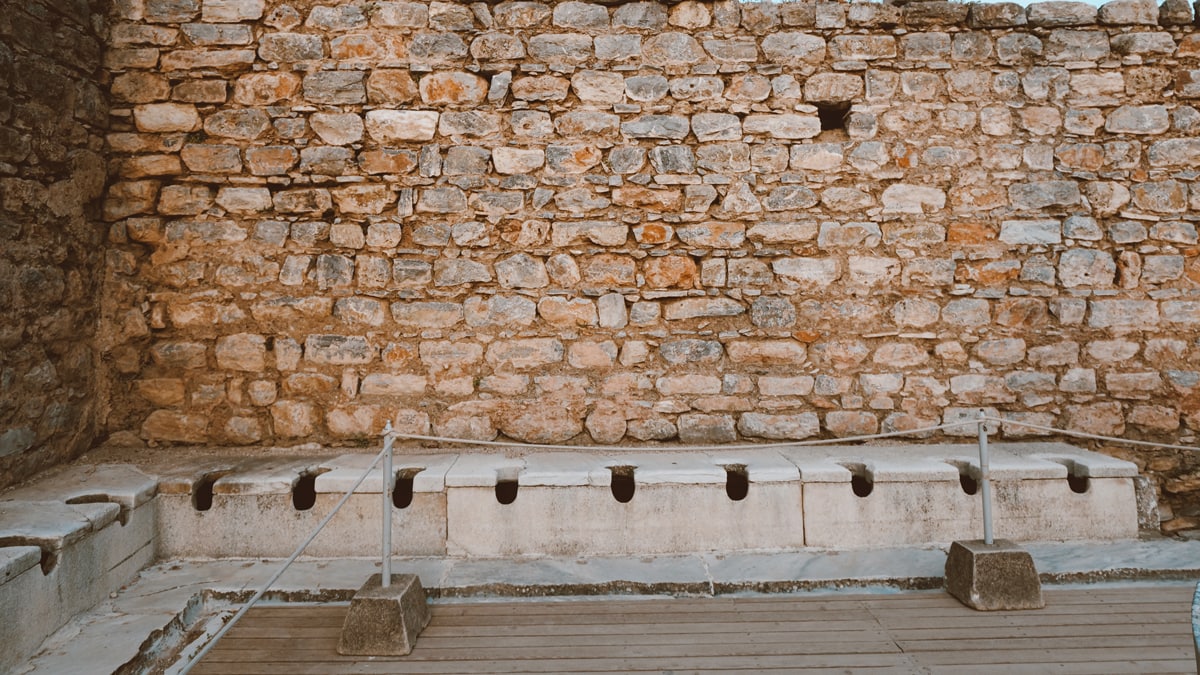
Public toilets were used by the people of the period to meet their toilet needs and socialize. Since the Skolastika Baths were right behind it and the water from the baths merged with the sewage, it was easier to mask foul odors.
Scholastica Baths
The Scholastica Baths, the large baths on your right as you walk down Kuretler Street, the main street, are believed to have been built in the second half of the 1st or early 2nd century AD. It is known that the baths were restored in the 400s AD by a Christian woman named Skolastikia. Hence the name Skolastika Baths. It consists of 4 sections: hot water room, warm water room, cold water room, and changing room. It is also thought that secret passages connected the baths to the Latrina (toilet) and the Love Houses (brothels of the period).
Mosaic Sidewalk
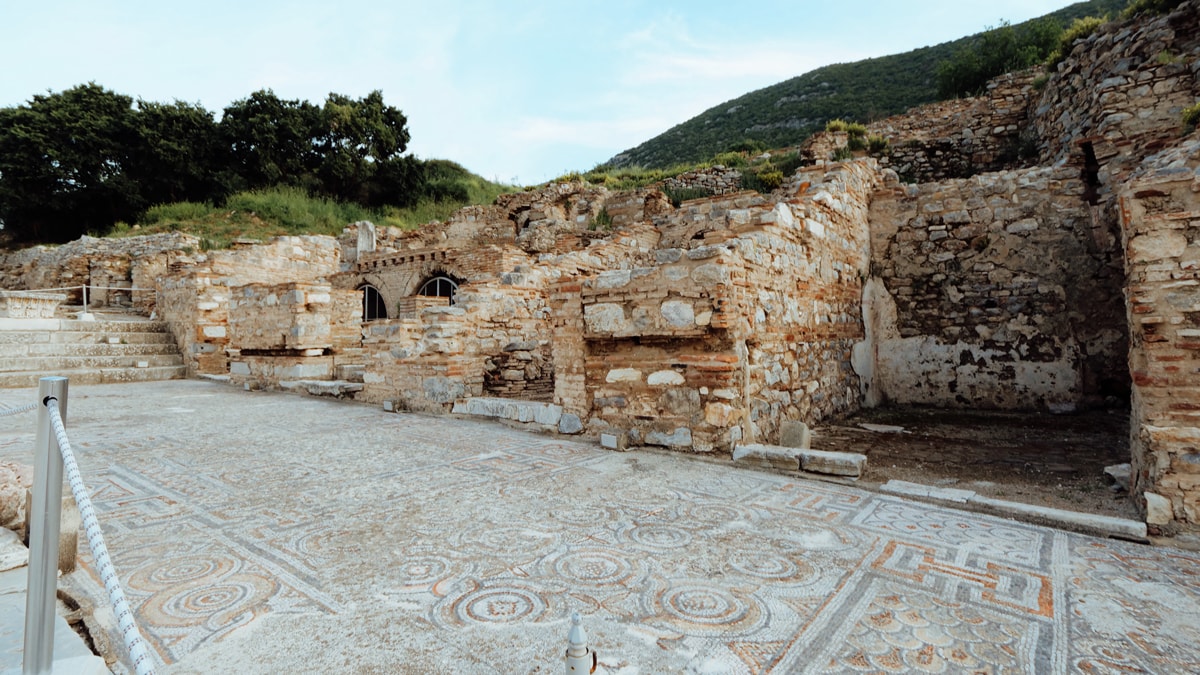
Opposite the Temple of Hadrian is this 5-meter wide mosaic pavement.
Temple of Hadrian
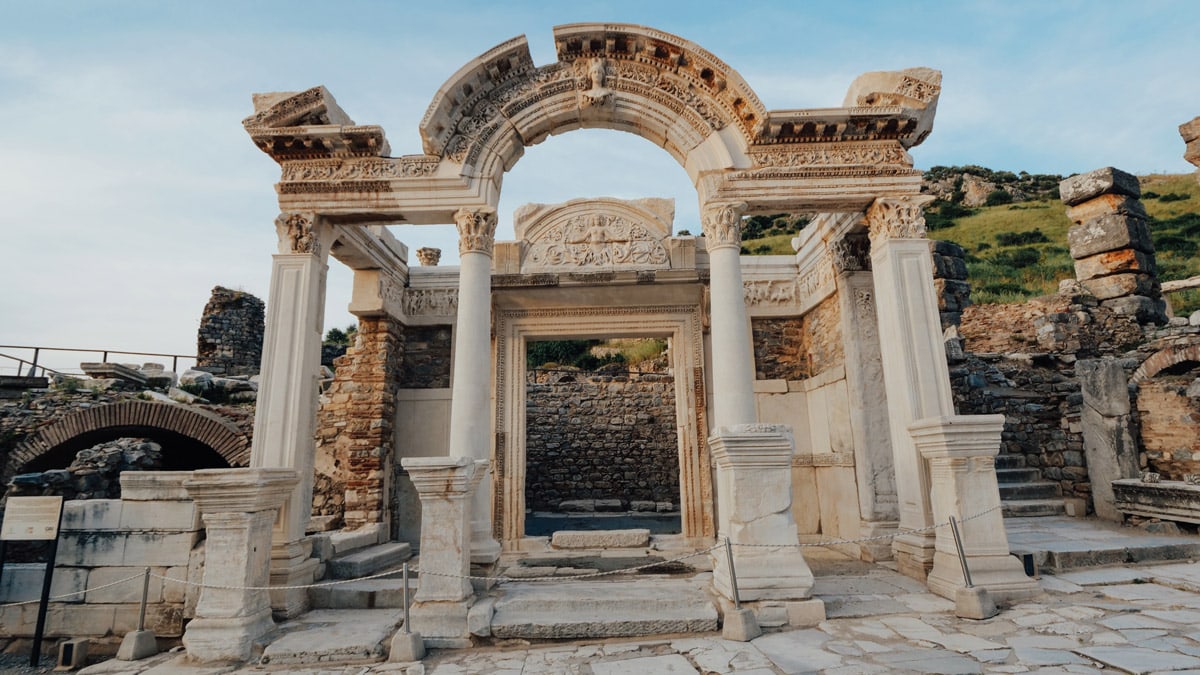
Hadrian’s Temple was built in honor of the Roman Emperor Hadrian. The purpose of the Temple was to honor Emperor Hadrian, who visited Ephesus in 128 AD. There are reliefs of Tike, the goddess of luck, and Medusa on the gate. The replacements of the Temple are in the Ephesus Museum. On the pedestals in front of the Temple were bronze statues of the four Roman emperors Galerius, Maximianus, Diocletianus, and Constantinus.
Fountain of Trajan
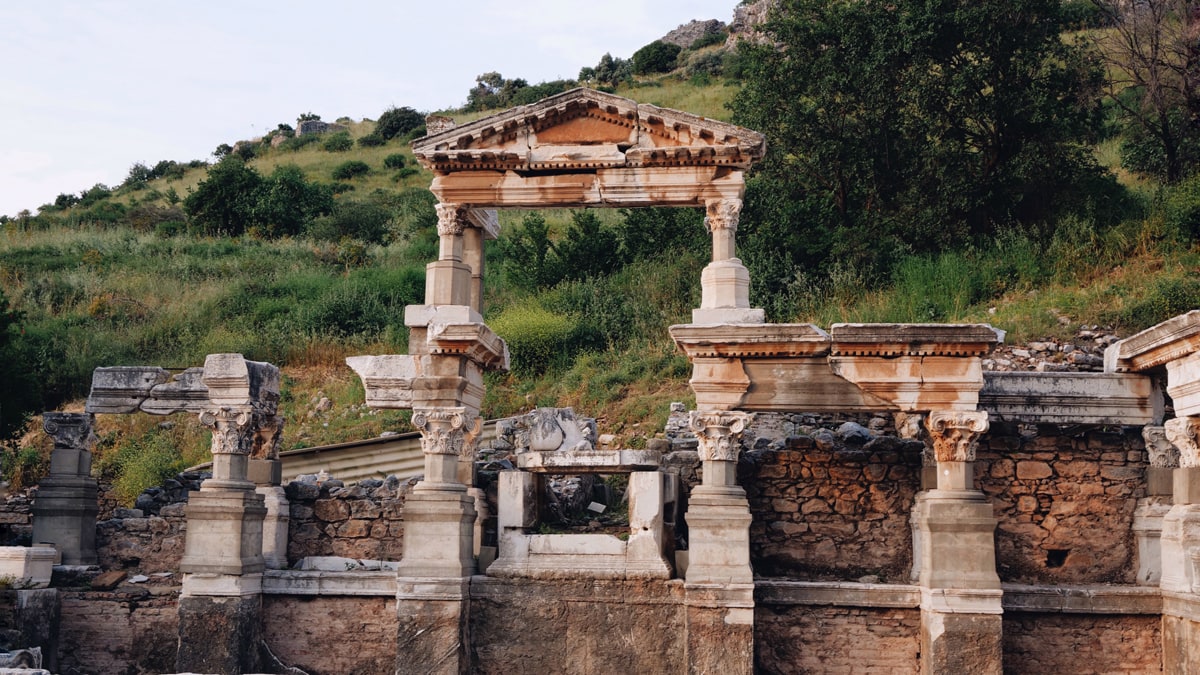
Trajan Fountain was built between 102-114 AD in the name of Roman Emperor Trajan and Artemis of Ephesus. Originally a 2-story fountain, it was restored and rebuilt as a single-story fountain. Some statues of the fountain are now on display at the Ephesus Museum and some at the British Museum.
Kuretler Street
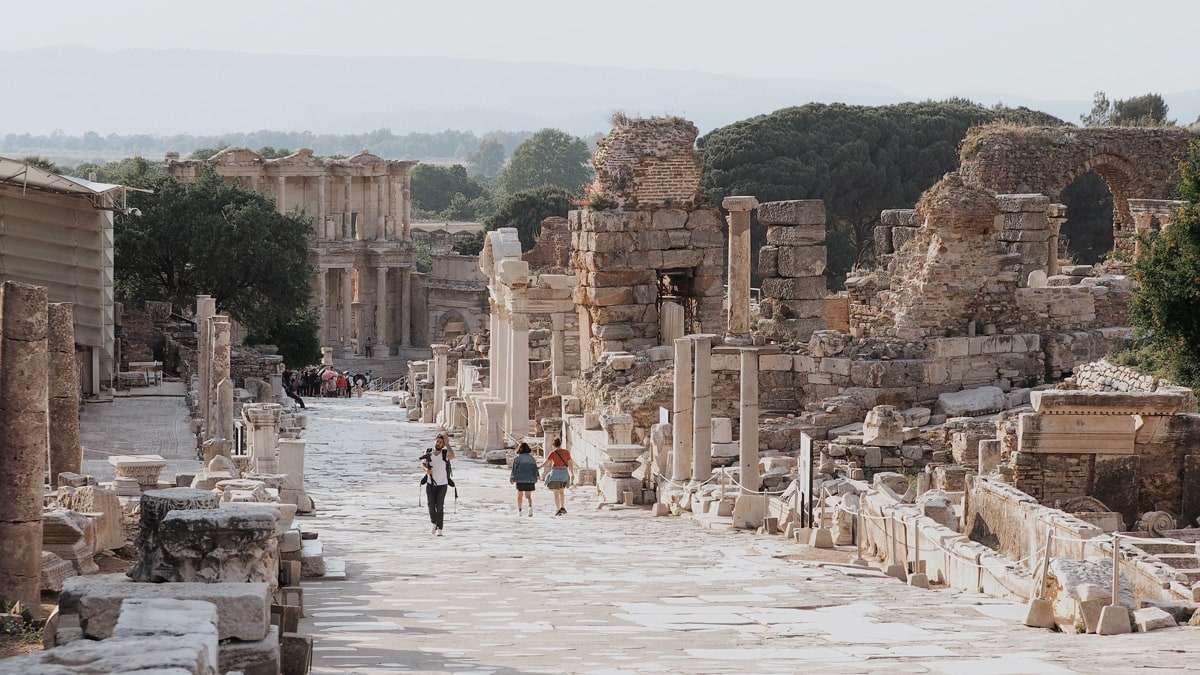
The main street from Heracles Gate and down towards the Library of Celsus is called Küretler Street. Trajan’s Fountain, Hadrian’s Temple, and Skolastika Baths are also on this street. The reason why this street is called Kuretler Street is based on mythology. The names of the Kurets, demigods in mythology, are written on the columns at the beginning of the street. That is why it is called “Kuretler Street.”
Heracles Gate
The Heracles Gate, built in the 4th century BC, takes its name from the reliefs representing “Heracles” (Greek Mythology) or “Hercules” (Roman Mythology) on its façade. This gate turns Kuretler Street into a pedestrian path. But it is known that only the nobles of Ephesus could pass through the gate.
Memmius Monument
The Memmius Monument is an honorary monument built in 30 AD in the square where the Temple of Domitian stands in honor of Gaius Memmius, a grandson of the Roman statesman Sulla Felix. The monument is in the shape of a tower, and the virtues of Gaius Memmius are depicted between the columns of the building.
Temple of Domitian
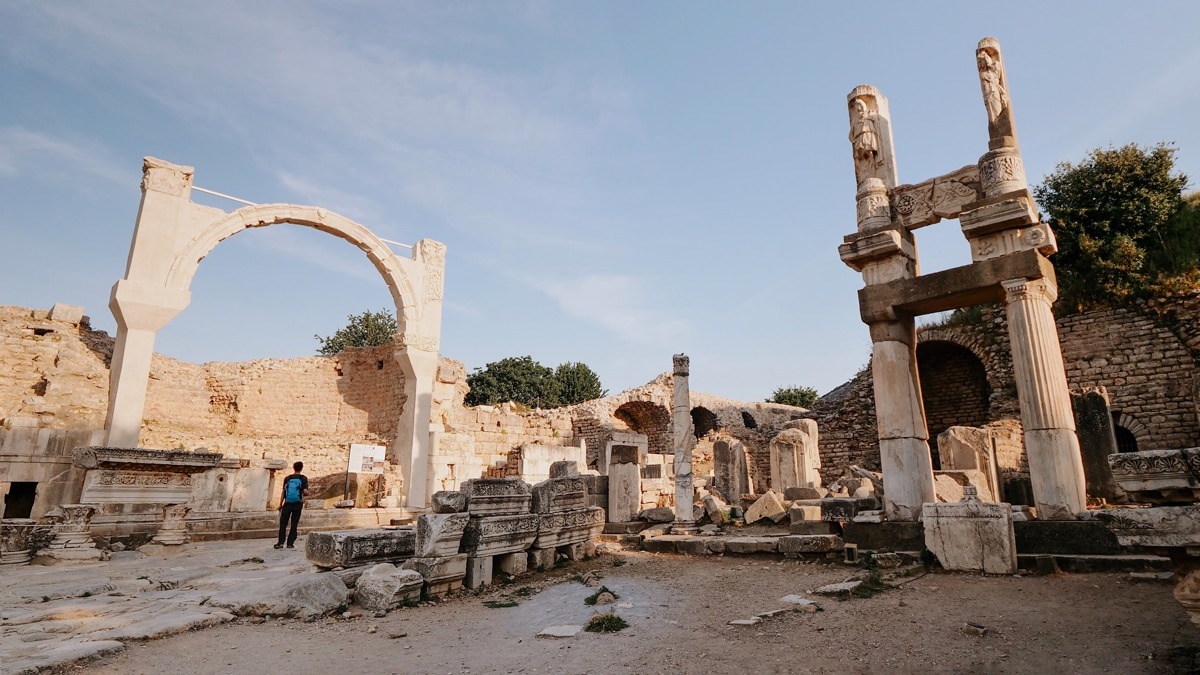
The Temple of Domitianus, built between 81-96 AD, is a temple built in the name of Emperor Domitianus. Emperor Domitianus was cursed for his cruel rule after his death. The Roman Senate decided to erase his name from all inscriptions. But the people of Ephesus did not want to demolish the temple entirely and cut off the head of the emperor’s statue in the temple and put the head of his father’s statue.
Town Hall (Prytaneion)
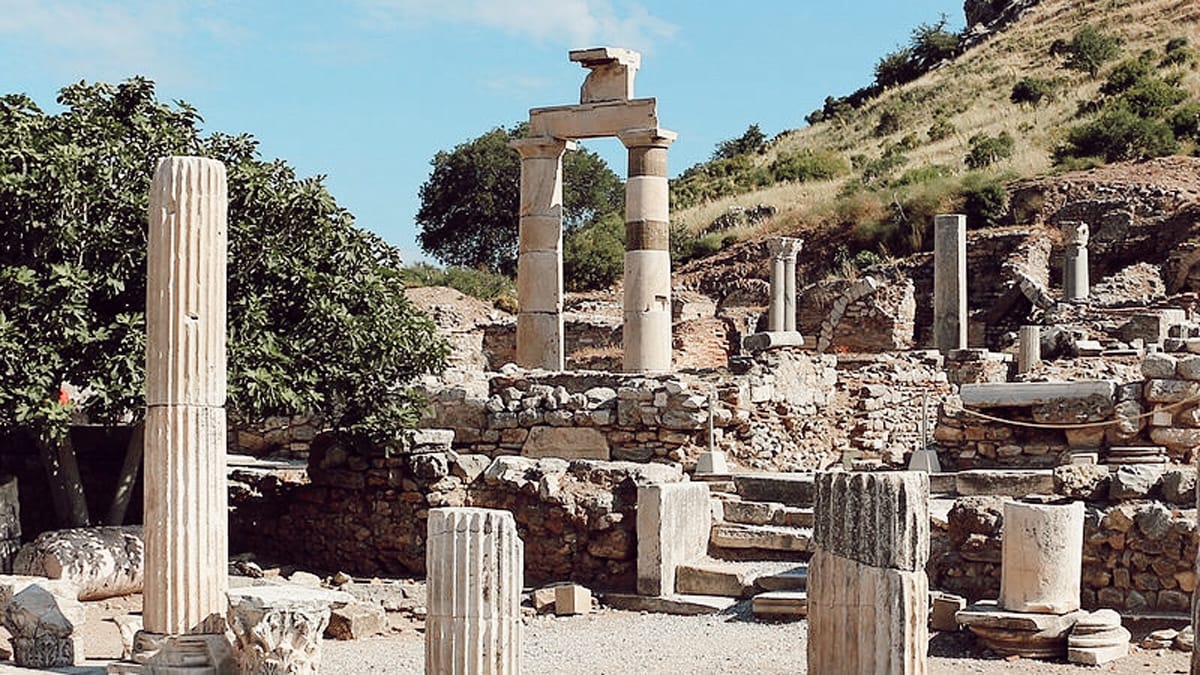
The Prytaneion, or Town Hall, built in the 1st century AD, dates back to the reign of Emperor Augustus. Here, issues related to city administration were discussed, and diplomatic relations were conducted. The office of the city’s top administrator is also located here. There is a banquet hall in the third courtyard of the building with three squares.
One of the structures unique to ancient Roman cities is odeons. Odeons are not as gigantic as amphitheaters. They allow smaller groups to hold meetings, especially the assembly, where council members meet and make critical decisions about the city’s future. The odeon of the ancient town of Ephesus dates back to 100 AD.
Ruins of Ephesus Outside the Ruins
House of Virgin Mary
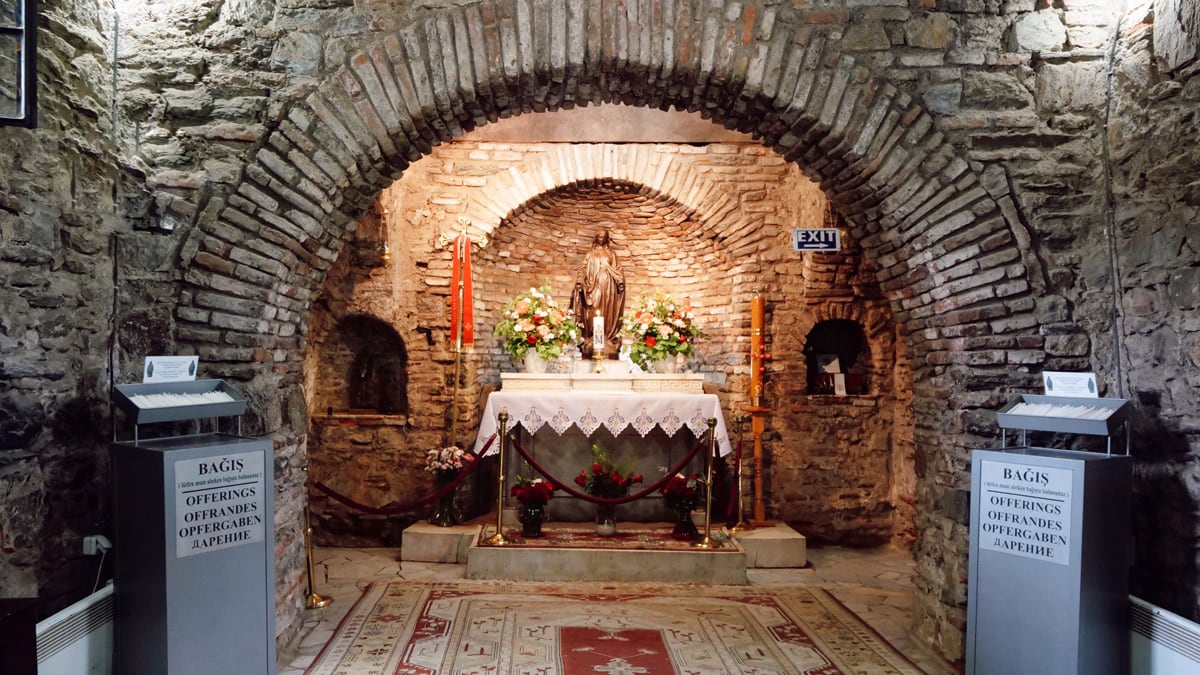
This is the church where Mary is thought to have spent her last years with St. John. The discovery of this church has a fascinating story.
Anna Katharina Emmerick, a woman living in a German village who had never left her town before, was stricken with a persistent illness. After becoming ill, she began to give coherent information about people she could not possibly know and places she could not maybe see. This attracts the attention of the writer Clemens Brentano, and he moves in with her. Brentano stayed with the woman until her death, and after her death, he wrote a book about Mary’s life based on her stories. In 1891, while reading this book in the French hospital in Izmir, there was a discussion about whether it could be true On July 29, 1891, this small group found this church in the light of what was described in the book.
Temple of Artemis
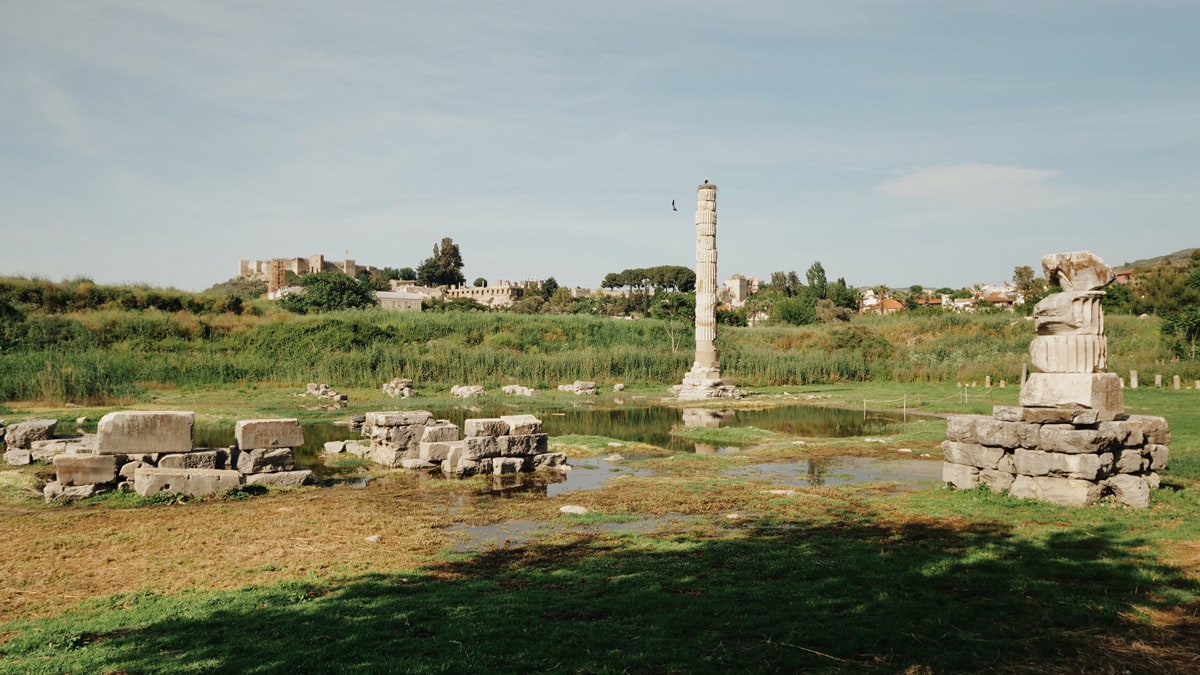
Much can be written, and much can be said about the Temple of Artemis, one of the seven wonders of the world, but no matter what we write, we cannot describe it as beautifully as Antipader of Sidon, who compiled the Seven Wonders of the World;
“I have seen the wall of proud Babylon with the road for chariots, and the statue of Zeus on Alpheus, and the hanging gardens, and the colossus of the sun, and the gigantic workmanship of the high pyramids, and the vast tomb of Mausolus; but when I saw the house of Artemis built on the clouds, all other wonders lost their luster, and I said, “Behold! Outside Olympus, the Sun has never looked upon anything so great.” (Antipater, Greek Anthology [IX.58])
Unfortunately, the temple has been lost to history, and no stone is left on stone, but the impression you get while touring the city is of how magnificent it was.
Church of St. Mary
As you know, the 3rd Ecumenical Council, one of the most important meetings of the Christian world, took place in this church in Ephesus. At the council, which convened in the ancient city of Ephesus in 431 AD, it was confirmed that Mary gave birth to the human child Jesus and God. The Church of Mary continued to be necessary until the 7th century A.D. but lost its importance when the Basilica of St. Jean was built and became the new bishopric center.
The Seven Sleepers
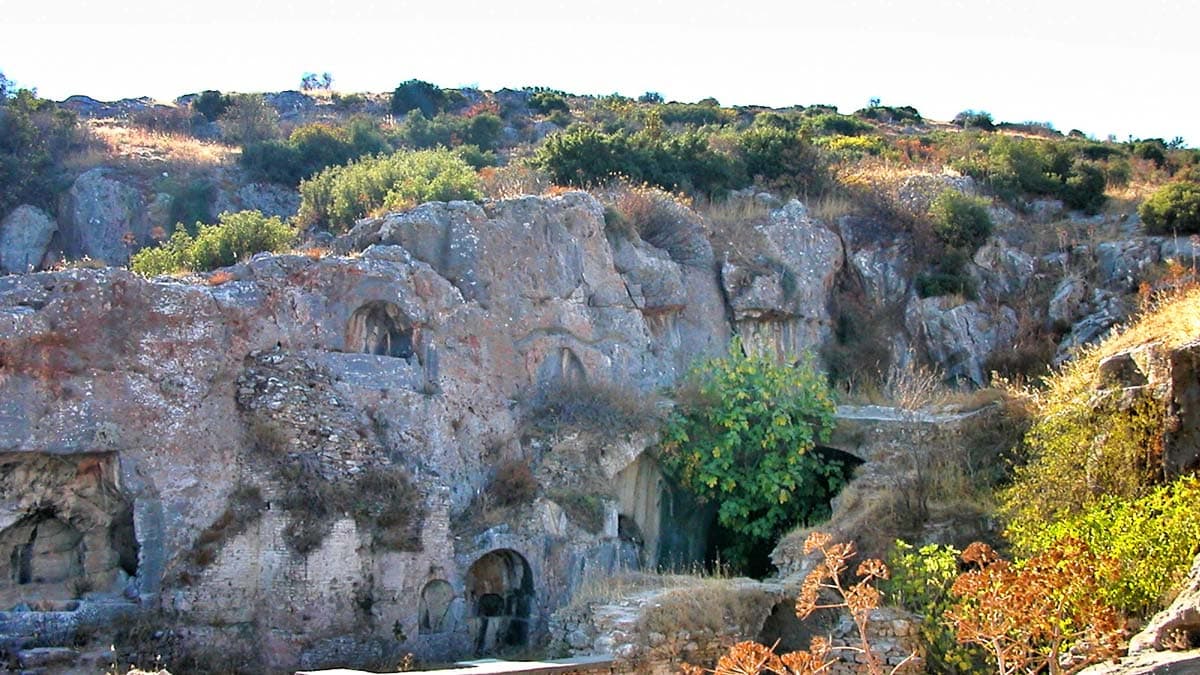
It is a legend that overlaps in many cultures, Christianity and Islam, with minor differences. The common point of all myths is that 7 people who abandoned their people, tired of the oppression of the rulers of the period, entered a cave and lived there.
The legend about the cave in Ephesus continues as follows. The ruler hears about the cave where these rebels fled and have the entrance of the cave closed and leaves the people inside to die and puts a sign at the entrance of the cave that he punishes the people inside. 200 years later, the owner of the land where the cave is located opens the door to the shelter and sees the seven sleepers there. This miracle came to light when some of the seven sleepers came down to the village to get food.
This is the legend, but there are 4 different points in our country and 33 different points in the world where the cave where the Seven Sleepers sleep is allegedly located.
Basilica of St. Jean
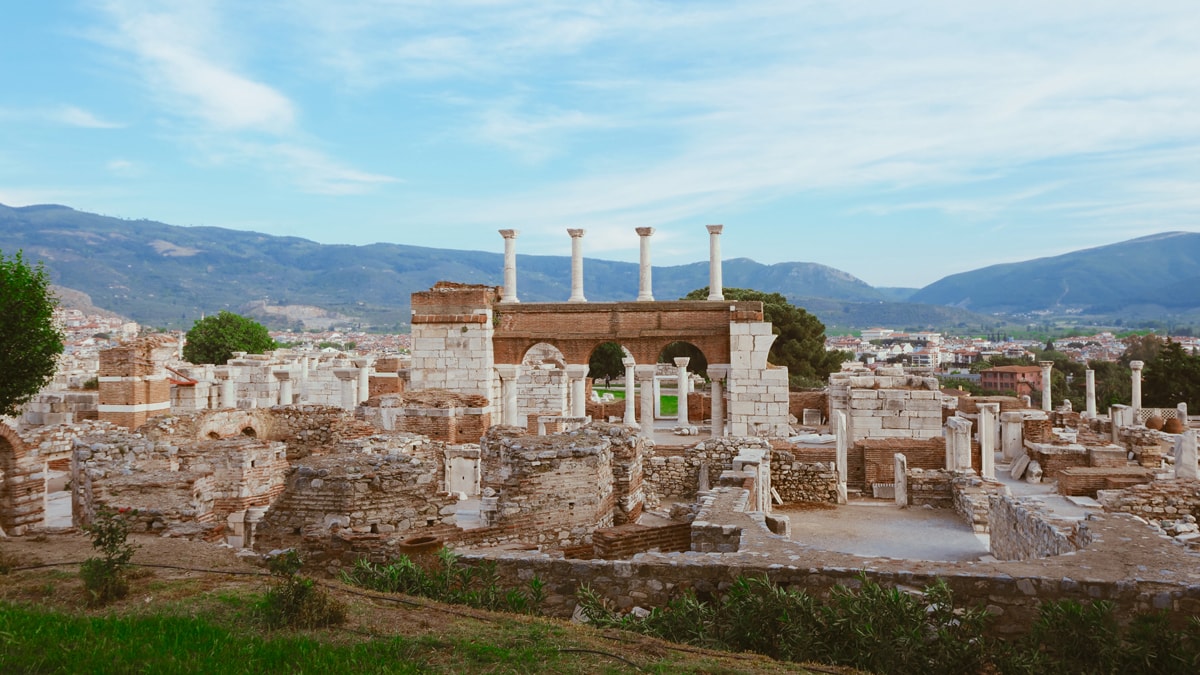
The basilica where the tomb of one of the most important figures of Christianity, one of the 12 apostles of Jesus Christ, “St. John or St. John,” known to the Christian world as St. Jean or St. Jean, is located. It is believed that he wrote the Gospel of John here. Later, the basilica here was built over St. Jean’s tomb, and the Basilica of St. Jean replaced the Church of Mary in Ephesus in importance. Considered one of the most essential pilgrimage points of the Christian world after Jerusalem, this basilica and the ruins surrounding it have been on the UNESCO World Heritage List with Ephesus since 2015.
The Importance of Ephesus for Christianity
– Ephesus played a vital role in the spread of Christianity. Beginning in the 1st century A.D., influential Christians such as St. Paul and St. Jean influenced the Artemis worshippers around Ephesus and converted them to Christianity.
-The third of the Ecumenical Councils, which was very important for the Christian world, convened in Ephesus in 431 AD at the invitation of Emperor Theodosios II. In this council, the ideas of Nestorius, the Patriarch of Constantinople, who argued that Mary gave birth to Jesus, who was only a human being, were rejected. It was accepted that Mary gave birth to God.
– It is believed that Mary, the mother of Jesus, spent her last years in this region with St. Jean. The House of Mary and the tomb of St. Jean can still be visited here today. Both are a 10-15 minute drive from the ancient city of Ephesus.
– Ephesus is mentioned several times in the New Testament, and the book of Ephesians, written around 60 B.C., is thought to be a letter from St. Paul to the Christians of Ephesus, although some religious scholars still question its origin.
Transportation to Ephesus Ancient City
The ancient city of Ephesus is located in the Selçuk district of Izmir and is perhaps the most suitable place to spend a day. Why am I saying this?
If you are heading towards Izmir from the direction of Aydın, if you turn to the Belevi Connection of the Aydın-İzmir highway, it is within 20 minutes,
If you are going to Kusadasi from the Aydın side, it is within 10 minutes by turning from Çamlik to Selcuk direction,
If you are going to Kusadasi from the Izmir side, you can easily reach it without going out of your way.
But if you say, “We will come especially to see this place,” your job is relatively easy.
Trains running on the Basmane-Söke or Basmane-Denizli routes also pass through Selçuk Station. Selcuk Station is only 650 meters from the ancient city of Ephesus. By the way, let’s not forget that this route’s ticket prices are pretty affordable.
For those coming by plane, the distance from Adnan Menderes Airport to the ancient city of Ephesus is 60 km and 43 minutes by car.
Where is Ephesus Ancient City?
Ephesus Ancient City is an ancient ruin in the Selçuk district of Izmir.
How far is the ancient city of Ephesus from major settlements by private car?
- Istanbul to central Ephesus is 541 kilometers, 6 hours 20 minutes,
- The distance between Ankara and central Efes is 620 kilometers, 7 hours and 20 minutes,
- Izmir center to Ephesus is 80 kilometers, 55-60 minutes,
- The distance between Aydin center and Efes is 130 kilometers and takes 2 hours and 10 minutes.
See These Places While You’re in Ephesus
- Sirince is only a minibus ride from here if you want to go.
- Kuşadası is only 20 kilometers and 25 minutes away by car. It will be an excellent solution for those who want to visit the ancient city and relieve the tiredness in the sea.
- Selçuk Airport is very close to the center (3.5 kilometers), and tandem free parachute jumps are made at the airport.

